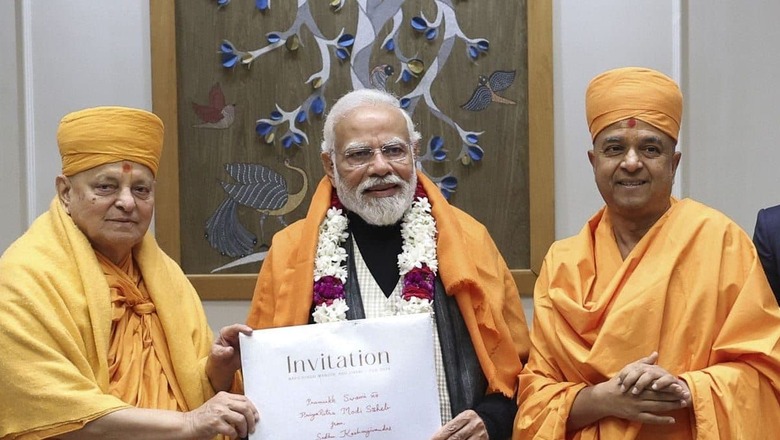
views
Prime Minister Narendra Modi will be attending the inauguration of Abu Dhabi’s landmark Hindu temple on February 14, 2024. He will attend a dedication ceremony in the evening after seven deities are consecrated and blessed in special morning prayers, said the BAPS Swaminarayan Sanstha on Thursday.
According to a report published by The National, this is UAE’s first traditional hand-carved Hindu temple and is located in Abu Dhabi’s Abu Mureikha area, off the main motorway between Dubai and the capital. It will open to the public on February 18.
The report stated that February 14 has been selected for the consecration ceremony as it is on Basant Panchami, an auspicious day for Hindus signalling the season of spring. “On February 14 morning, there will be the murti pratishtha or invocation of the murtis (idols) and in the evening, we will have a public dedication ceremony in the presence of Prime Minister Narendra Modi,” Pranav Desai, the temple project director, told The National.
“It is truly overwhelming for us to see the final phase, the final stretch of work being completed,” he was quoted as saying.
The prime minister had launched the ambitious project in 2018. The temple has seven spires to reflect the Emirates. He was personally invited on behalf of the BAPS Hindu Mandir by Swami Ishwarcharandas and Swami Brahmaviharidas, along with the board of directors.
The representatives of the BAPS Swaminarayan Sanstha adorned the prime minister with a garland and presented a saffron shawl to him. The one-hour informal meeting was held at the prime minister’s residential office and talks revolved around the new temple’s significance for global harmony and Modi’s vision for India’s spiritual leadership on a global stage.
Temple with seven spires represents the Emirates
The iconic temple has seven spires representing the Emirates, with intricate handmade carvings on its walls. The much-anticipated religious site features sculptures set in pink sandstone and white marble. The National report stated that the sculpting work began in 2020.
Desai told The National that each section of the temple tells the story of the life and teaching of Hindu deities worshipped across India, while the etchings also relate teachings from other cultures as a mark of respect for all religions.
“The spires symbolically represent the seven emirates of the UAE as our way to say thank you to the leadership,” Desai was quoted as saying. “The seven spires will have deities from the north, south, east and west of India. There will also be 14 value tales from the Arabic region, Chinese, Aztec and from Mesopotamia that show how love is universal across all cultures.”
Here is all you need to know about the unique features of the temple:
- The BAPS Hindu Mandir can accommodate 8,000 to 10,000 visitors and will be open to all faiths. The temple complex has prayer halls, a community centre for cultural events, a library, children’s park and an amphitheatre. Prayer ceremonies will begin at the temple from February 10 as part of a festival of harmony.
- Visitors, when they enter the temple, will see two streams of water that are a symbolic representation of Ganga and Yamuna rivers. A beam of light will represent the mythological Sarasvati river and will be trained under the temple structure.
- Elaborate carvings depict celebrations in the ancient town of Ayodhya to welcome home Hindu deity Ram returning from his 14-year exile. At least 2,000 artisans from Rajasthan and Gujarat carved 402 white marble pillars in the last three years. Not a single pillar has the same carvings as each depict different stories from Indian scriptures.
- Iron or steel reinforcements have not been used during the construction of the temple, in keeping with how temples were built in ancient India. More than 20,000 tonnes of stone and marble were shipped in over 700 containers to Abu Dhabi over three years.
- The temple has been built using the compression method with granite at the bottom, layered with pink sandstone and marble pillars. It was like a big jigsaw puzzle coming together as each carving was marked with a specific number in India, placed inside a wooden crate with the same marking and secured into place at the temple site marked with the same code.














Comments
0 comment